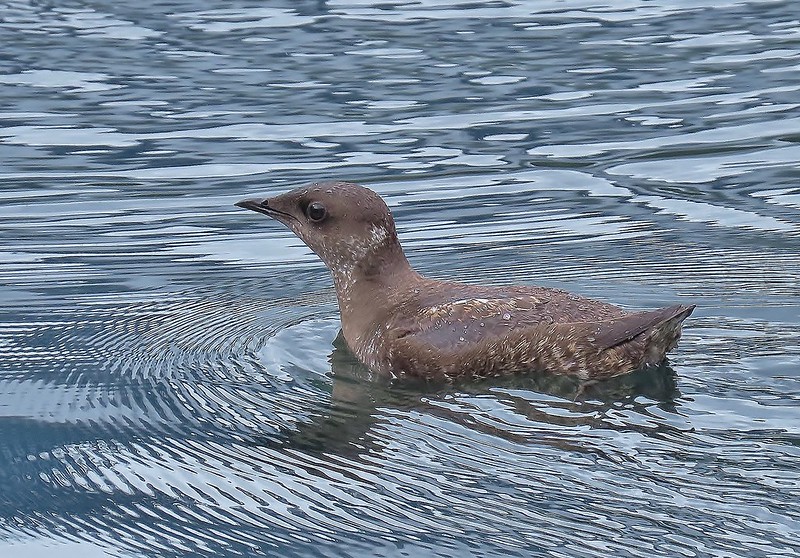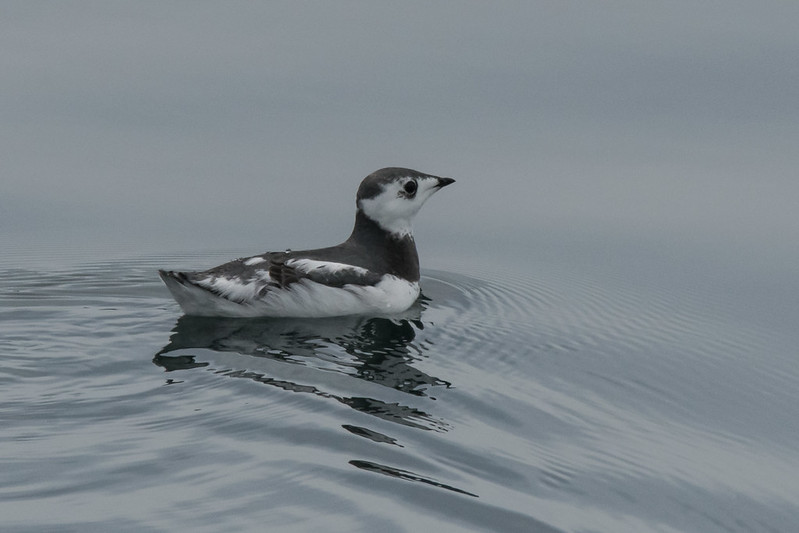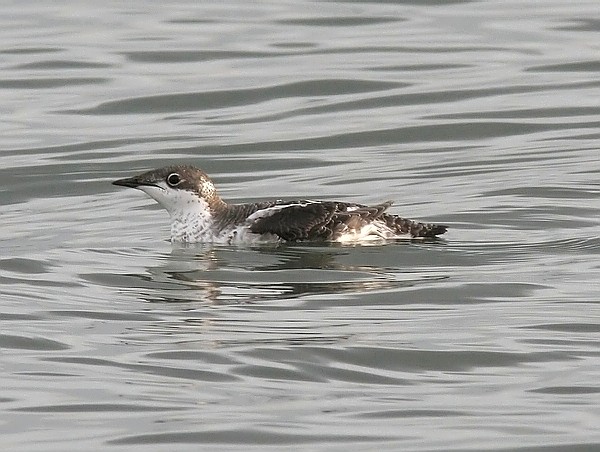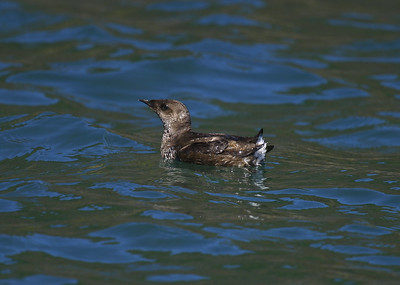Did you know that there’s a small, elusive bird that has an unusual nesting behavior that sets it apart from all other alcids? Meet the Marbled Murrelet – a stout auk bird that is only around 10 inches long.
With its cooperative foraging habits and piercing calls, the Marbled Murrelet is an intriguing species that inhabits coastal waters, bays, and mountains of the north Pacific Ocean. But this fascinating bird is in danger.
Marbled Murrelets are listed as an endangered species on the IUCN Red List due to the impact human activity has on its habitat.
Identification
The Marbled Murrelet is a type of small, stout auk bird that is around 10 inches long and has a 9.5-10 inches wingspan. The bird has a blocky shape due to its short neck and tail. It has a thin, pointed bill and long, narrow wings. Its appearance changes depending on the season, but male and female birds look the same.
During the breeding season, the bird appears brown overall with its upper plumage being a warm brown color while its underside is brown with an off-white mottling.

© Guy Monty
However, during the non-breeding season, its plumage becomes black above and white below, with a white patch on its face, a white bar near its shoulder, and a white collar separating its dark crown from its back.
Juvenile Marbled Murrelets look similar to nonbreeding adults, but the black is rather a darker gray.
Marbled Murrelets call in nesting areas and at sea. The calls are different versions of piercing and loud whistles. The most common call sounds like keer. You might also hear whirring sounds when they’re flying nearby.
You can find Marbled Murrelets near the shore, in areas with rocky cliffs or islands, and typically fly close to the water.
Food
Marbled Murrelet’s diet mainly consists of small fish and zooplankton that they catch underwater with their bill, mostly near the shoreline. They dive rapidly, using their wings to “fly” underwater and their feet to pursue prey quickly and agilely. Dives usually last less than a minute and are relatively shallow.
They forage alone, in pairs or flocks, and also join mixed-species seabird flocks. To make capturing prey more efficient, they work cooperatively, herding small fish together as a team. Food sources can be concentrated by different marine features such as tides, rip currents, or upwellings, and large groups of murrelets can gather when food is abundant.
The adults typically eat smaller prey but feed their young larger fish. They consume a variety of prey species, including sandlance, anchovy, herring, sardine, sandfish, capelin, seaperch, smelt, pollock, needlefish, candlefish, salmon, rockfish, codfish, scorpionfish, and prickleback.
Additionally, they feed on small shrimp such as prawns, and squid such as opalescent inshore squid.
In the northern part of their range, they often feed heavily on zooplankton such as euphausiids, mysids, and amphipods. During summer, you may also find them foraging in freshwater lakes.
Marbled Murrelets usually forage up to 0.3 miles from the shoreline in waters less than 100 feet deep. They typically forage both during the day and at night.
Nesting and Eggs
This bird breeds on coastal mountains and has an unusual nesting behavior that sets it apart from other alcids. Instead of nesting in groups on cliffs or in burrows, the Marbled Murrelet nests on large branches of mature conifers or on the ground in subalpine areas or islands.
The nest site can vary widely, from ground level in sparse or dense growth to branches high up in dense forests up to 150 feet above the ground, within 15 miles of the coast or inland. Old-growth forests are the preferred location for nesting, and the largest tree in the area is typically chosen for the nest.
The female Marbled Murrelet lays a single egg directly onto a mossy branch or on the ground in a shallow depression, using a disused bird or squirrel nest or platform of dead vegetation if available.
Both parents, including the male Marbled Murrelet, take turns incubating the egg, which is pale olive green to greenish yellow spotted in dark colors, for approximately four weeks, and the chick is fed by both parents until it is ready to leave the nest after 27-40 days.
Fledglings fly unaccompanied to the ocean, and the breeding success rate is low due to high chick mortality. The breeding behavior of the Marbled Murrelet is not well-known due to the scarcity of nests discovered.
Current Situation
Marbled Murrelets range in the shoreline regions of the north Pacific Ocean, stretching from the western coast of Japan to Kamchatka, Russia, and from central California to southern Alaska along the eastern coast.
Marbled Murrelet’s habitats are near coastal waters, tide rips, bays, and mountains, with a range of up to 1.2 miles from the shore. Some have been seen up to 59 miles inland.
They typically occur in calm, protected waters near the coast, including bays, inlets, and among islands, and mostly forage in shallow water. The birds are mainly found in old-growth forests near the coastline.
Marbled Murrelets don’t have a large population and are listed as an endangered species on the IUCN Red List. They’re threatened by logging, hunting, harvesting of aquatic resources, pollution, and habitat alteration. Their low reproduction rate is also a reason for the decrease in numbers.
Facts
- The Marbled Murrelet has some interesting nicknames, such as the Australian Bumblebee, fogbird, or fog lark.
- Over 85% of Marbled Murrelet’s population resides in the harbors of Alaska.
- Marbled Murrelets are the only known alcids that nest in old-growth trees. There are only a few dozen known nest locations. Scientists first discovered that their nests are in trees in the 1950s and 1960s when loggers found adults, juveniles, and eggs in cut-down trees.
- Marbled Murrelets are highly sensitive to light pollution and are easily disoriented by artificial lights near their nesting areas.
- Marbled Murrelets’ flight can reach a speed of 60 mph, making them one of the fastest-flying seabirds.
Similar Species
Marbled Murrelet has two very similar species that are also murrelets. The differences are subtle, so be sure to pay attention.

© Tim Melling
Kittlitz’s Murrelet
Both breeding and nonbreeding plumages of the two birds are very similar.
However, Kittlitz’s Murrelets have shorter bills, an overall mottled lighter brown breeding plumage, and nonbreeding birds have white extending all the way around the face.

© Nic Hallam
Long-billed Murrelet
Breeding Long-billed Murrelets have a white throat instead of a dark one and as the name suggests, a longer bill.
Their non-breeding plumage is almost indistinguishable, except for the fact that the Long-billed Murrelets lack the white collar the Marbled Murrelet has.
FAQ
Are Marbled Murrelets rare?
Marbled Murrelets are rare seabirds with a limited range and a decreasing population. They’re listed as endangered on the IUCN Red List.
What is being done to protect the Marbled Murrelet?
Marbled Murrelets are threatened by logging, habitat loss and alteration, climate change, pollution, and entanglement. To protect Marbled Murrelets, conserving old forests that act as their nesting grounds should be a top priority.
Why is the Marbled Murrelet important?
Marbled Murrelet is an important part of the ecosystem and food chain. Their excrement is rich in phosphates and nitrates which is important for ocean food pyramids.
Is the Marbled Murrelet a carnivore?
Marbled Murrelet is a carnivore, specifically a piscivore.
How deep do Marbled Murrelets dive?
Marbled Murrelets usually dive to depths of 60-100 feet.

